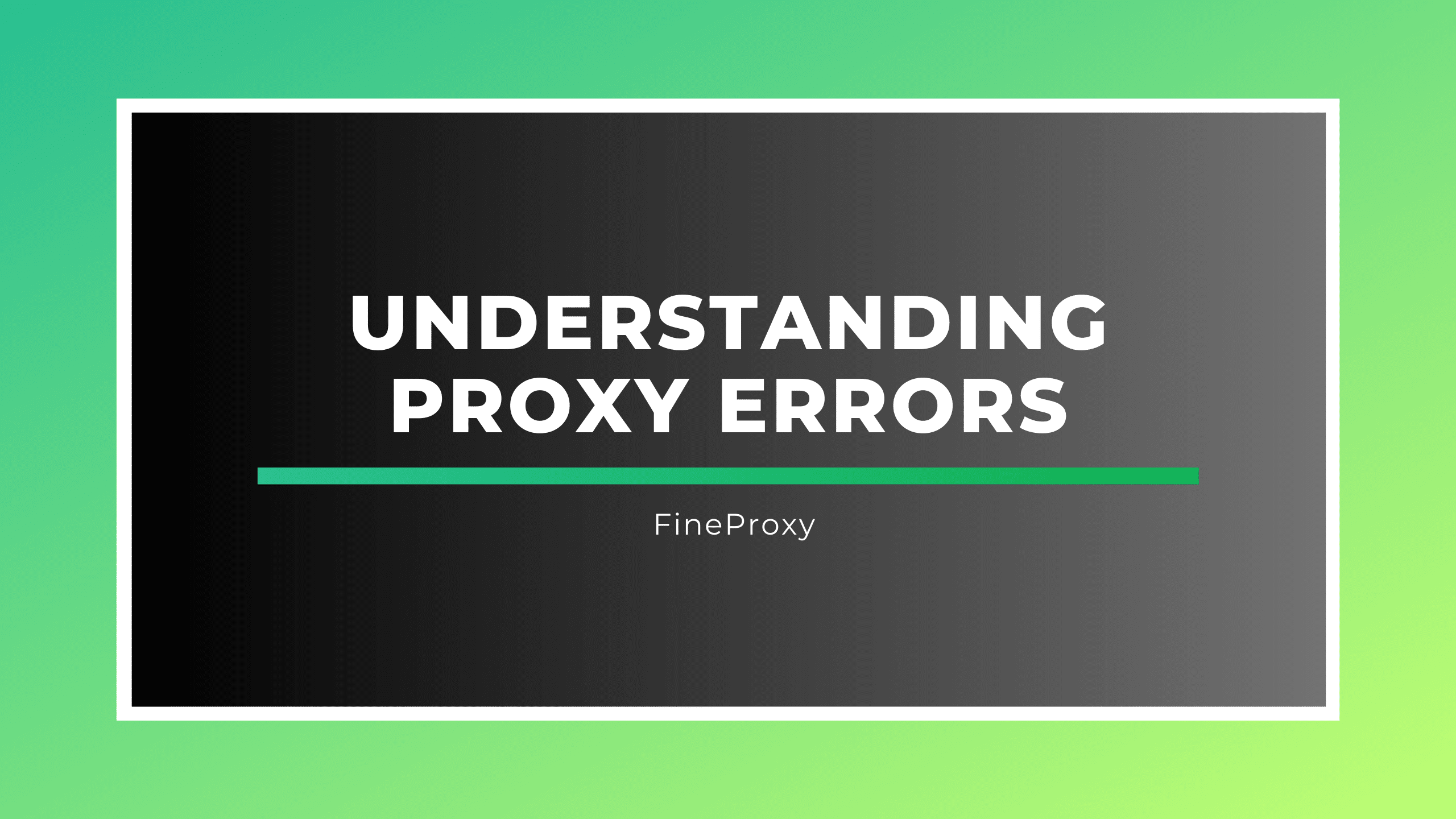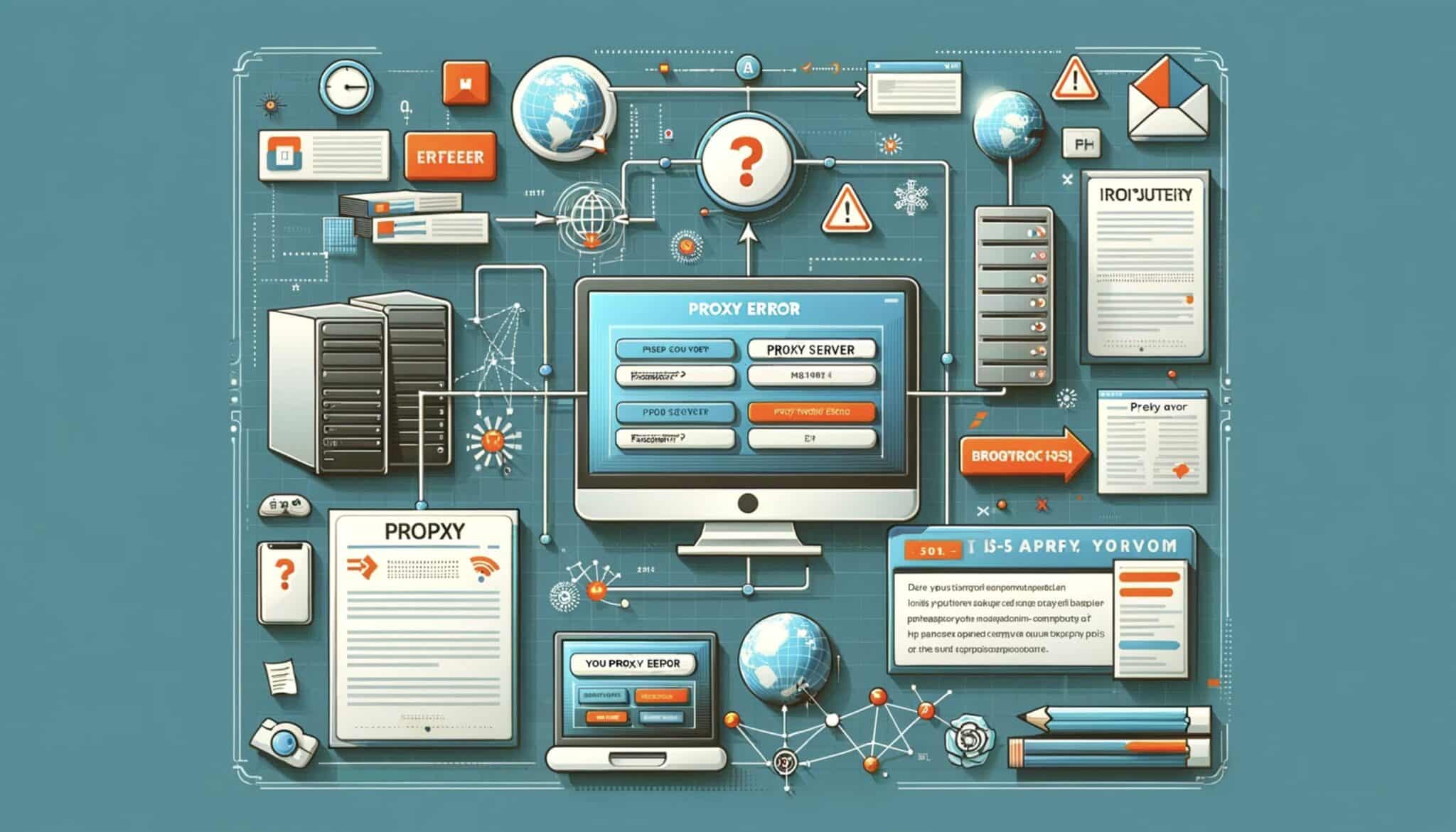
- What is a proxy error and how does it differ from a DNS error?
- What are the common causes of proxy errors?
- How can one effectively troubleshoot and resolve proxy errors?
- What are the different types of proxy errors and their specific meanings?
- What preventive measures can be taken to avoid proxy errors in the future?
Proxy errors can be incredibly frustrating when you’re trying to access a website or an online service. They can disrupt your online experience and leave you wondering what went wrong. In this article, we will delve into the world of proxy errors, providing you with a clear understanding of what they are, how they occur, and how to tackle them effectively.

Definition of Proxy Error
A proxy error, in simple terms, is an HTTP status code that indicates a problem between your computer and the proxy server. Proxy servers act as intermediaries between your device and the web server you’re trying to reach. When a proxy error occurs, it means that there’s an issue preventing your request from reaching the destination server or returning a response.
How Proxy Errors Occur
Understanding how proxy errors occur is essential for troubleshooting and fixing them. These errors can manifest for various reasons, such as:
- Server Overload: Sometimes, the proxy server may be overwhelmed with requests, leading to a proxy error. This can happen during periods of high traffic or when the server experiences technical difficulties.
- Misconfigured Proxy Settings: Incorrectly configured proxy settings on your device can lead to communication issues with the proxy server, resulting in errors.
- Network Connectivity Issues: Problems with your internet connection or network can disrupt the communication between your device and the proxy server.
- Firewall Restrictions: Firewall rules and security settings can sometimes block or interfere with proxy server communication, leading to errors.
Common Types of Proxy Errors
Proxy errors come in various flavors, each with its own unique characteristics. Understanding these types is crucial for diagnosing and resolving the issue effectively.
HTTP 502 Proxy Error
The HTTP 502 Proxy Error, often referred to as the “Bad Gateway” error, occurs when the proxy server receives an invalid response from the destination server. This can happen when the destination server is down, overloaded, or experiencing issues.
HTTP 503 Proxy Error
The HTTP 503 Proxy Error, known as the “Service Unavailable” error, indicates that the proxy server can’t access the required service or resource. This can occur due to server maintenance, server overloads, or misconfigurations.
HTTP 504 Proxy Timeout Error
A common occurrence, the HTTP 504 Proxy Timeout Error, suggests that the proxy server didn’t receive a timely response from the destination server. This could be due to slow server response times or network issues.
SOCKS Proxy Error
The SOCKS Proxy Error occurs when there’s an issue with a SOCKS (Socket Secure) proxy server. This type of proxy is commonly used for routing network packets between your device and the server. SOCKS proxy errors can arise from misconfigurations or connectivity problems.
Causes of Proxy Errors
Now that we’ve explored the different types of proxy errors, let’s dig deeper into the underlying causes.
Server Overload
Server overload is a common cause of proxy errors. When a proxy server is inundated with requests beyond its capacity, it can’t effectively process them all, leading to errors.
Misconfigured Proxy Settings
Misconfigured proxy settings on your device can disrupt the communication between your computer and the proxy server. This often happens when proxy settings are entered incorrectly or conflicts arise in your network configuration.
Network Connectivity Issues
Problems with your internet connection or network can result in proxy errors. Network disruptions, such as dropped connections or high latency, can prevent your device from effectively communicating with the proxy server.
Firewall Restrictions
Firewalls are designed to protect your network by blocking or allowing specific types of traffic. However, overly strict firewall rules can interfere with the proper functioning of proxy servers, leading to errors.
In conclusion, understanding proxy errors and their underlying causes is crucial for effectively resolving these issues. Whether you encounter an HTTP 502 Proxy Error, HTTP 503 Proxy Error, HTTP 504 Proxy Timeout Error, or a SOCKS Proxy Error, knowing the root cause and implementing the appropriate solutions can help you navigate the complexities of proxy errors and enjoy a smoother online experience.
Troubleshooting Proxy Errors
What is a proxy error and what does unsuccessful HTTP response mean? Proxy errors can be a frustrating roadblock in your online experience. However, there’s no need to worry. In this comprehensive guide, we’ll explore the art of troubleshooting proxy errors, equipping you with the knowledge and tools to overcome these hurdles effectively.
Checking Internet Connection
Before diving into the intricacies of proxy error troubleshooting, start with the basics. Ensure that your internet connection is stable and active. A weak or interrupted connection can often mimic proxy errors. If your connection is the culprit, resolve it to proceed smoothly.
Reloading the Page
Sometimes, proxy errors can be transient glitches. A simple but effective initial step is to reload the webpage you’re trying to access. Browsers occasionally encounter hiccups, and reloading the page might clear the issue.
Clearing Browser Cache and Cookies
Cached data and cookies can accumulate over time, causing conflicts with the proxy server. Clearing your browser’s cache and cookies is a proactive measure to eliminate potential obstacles. It can refresh your browsing experience and resolve some proxy errors.
Testing with Different Browsers
If you’re encountering proxy errors consistently on one browser, it’s worth testing the same website or service on a different browser. This step can help determine whether the issue is browser-specific or related to the proxy server itself.
Contacting Website Support
In some cases, the issue may not be on your end but with the website or service you’re trying to access. Reach out to their customer support or check their status page for any ongoing issues. They might be aware of the problem and actively working to resolve it.
How to Fix Proxy Errors
Now that we’ve covered troubleshooting steps, let’s explore various methods to fix proxy errors when they persist.
Refreshing the Page
A quick and easy solution for some proxy errors is to hit the refresh button on your browser. This action prompts your browser to resend the request to the proxy server, potentially resolving the issue.
Restarting Your Router or Modem
Resetting your network equipment can help clear any temporary glitches. Power off your router or modem, wait a few seconds, and then power it back on. This action can establish a fresh connection to the proxy server.
Adjusting Proxy Settings
If you suspect that misconfigured proxy settings are causing the issue, review and adjust them as needed. Ensure that the proxy server settings on your device match the recommended configuration. Incorrect settings can lead to communication problems with the proxy server.
Disabling VPN or Proxy Server
If you’re using a VPN or another proxy server in addition to the one you’re encountering errors with, consider disabling it temporarily. Multiple layers of proxying can sometimes lead to conflicts and errors.
Checking Firewall Settings
Firewalls play a vital role in network security but can occasionally block or interfere with proxy server communication. Review your firewall settings and ensure they aren’t overly restrictive. Adjust them if necessary to allow the necessary traffic.
Proxy Error vs. DNS Error
Understanding the difference between a proxy error and a DNS error is essential for effective troubleshooting.
Key Differences
- Proxy Error: A proxy error occurs when there’s a problem with the intermediary server (the proxy) that sits between your device and the destination server. It typically manifests as an HTTP status code (e.g., HTTP 502 Proxy Error) and indicates a breakdown in communication.
- DNS Error: A DNS (Domain Name System) error, on the other hand, relates to domain name resolution. It occurs when your device can’t translate a domain name into an IP address to reach the intended server. DNS errors often result in “Page Not Found” or “Server Not Found” messages.
How to Identify the Issue
Distinguishing between proxy errors and DNS errors is crucial. If you’re seeing a specific error code (e.g., 502 or 503), it’s likely a proxy error. However, if you encounter issues related to domain name resolution or can’t access websites by their domain names, you may be dealing with a DNS error.
In conclusion, proxy errors can be vexing, but armed with the knowledge of troubleshooting techniques and the ability to distinguish between proxy and DNS errors, you’re well-prepared to navigate and overcome these challenges. By following the steps outlined here, you can streamline your online experience and resolve proxy errors with confidence.
Proxy Error Messages
Proxy errors can be a frustrating encounter in your online journey. Understanding these errors and how to interpret and resolve them is essential for a smoother online experience. In this article, we will explore common proxy error messages, provide insights into their interpretation, and offer solutions to address them effectively.
Common Proxy Error Messages
Proxy errors manifest in various forms, each with its unique message. Here are some of the most common proxy error messages:
- HTTP 502 Proxy Error: This error signifies a bad gateway and is often encountered when the proxy server receives an invalid response from the destination server.
- HTTP 503 Proxy Error: A “Service Unavailable” error that occurs when the proxy server cannot access the required service or resource.
- HTTP 504 Proxy Timeout Error: This error suggests that the proxy server did not receive a timely response from the destination server. It can be due to slow server response times or network issues.
- SOCKS Proxy Error: Specific to SOCKS (Socket Secure) proxy servers, this error can arise from misconfigurations or connectivity problems in routing network packets.
Interpretation and Solutions
Understanding the meaning behind these error messages is crucial for effective troubleshooting. Here’s how to interpret them and find solutions:
- HTTP 502 Proxy Error: When you encounter this error, it indicates that there’s an issue with the proxy server receiving an invalid response from the destination server. To resolve it, you can try refreshing the page or contacting the website’s support team.
- HTTP 503 Proxy Error: This error signifies that the proxy server can’t access the required service or resource. It can result from server maintenance, overloads, or misconfigurations. Contact the website’s support or wait for the issue to be resolved on their end.
- HTTP 504 Proxy Timeout Error: If you see this error, it suggests that the proxy server didn’t receive a timely response from the destination server. You can try refreshing the page or checking your internet connection.
- SOCKS Proxy Error: SOCKS proxy errors often require troubleshooting at the network level. Check your proxy server settings, ensure proper configuration, and investigate any network connectivity issues.
Proxy Error Prevention
While knowing how to interpret and resolve proxy errors is essential, preventing them in the first place is even better. Let’s explore some best practices to avoid proxy errors:
Best Practices to Avoid Proxy Errors
- Regularly Update Proxy Settings: Ensure that your proxy server settings are up to date and correctly configured. Outdated or misconfigured settings can lead to errors.
- Monitor Network Traffic: Keep an eye on your network traffic for any unusual patterns or issues. Promptly address any network disruptions or connectivity problems.
- Use Reliable Proxy Servers: Choose reputable proxy servers with a track record of reliability. Reliable proxies are less likely to cause errors or disruptions.
Proxy Error FAQs
Now, let’s address some frequently asked questions about proxy errors:
Frequently Asked Questions about Proxy Errors
- What causes proxy errors? Proxy errors can occur due to server overloads, misconfigured proxy settings, network connectivity issues, firewall restrictions, or issues on the website’s end.
- How can I fix a proxy error? You can fix proxy errors by refreshing the page, restarting your router or modem, adjusting proxy settings, disabling VPN or additional proxy servers, and checking firewall settings.
- Are proxy errors the same as DNS errors? No, they are different. Proxy errors relate to issues with intermediary servers, while DNS errors involve problems with domain name resolution.
Expert Answers to Common Queries
- Why do I encounter HTTP 502 Proxy Errors frequently? HTTP 502 errors often occur when the destination server is down or experiencing issues. Contact the website’s support team or wait for the issue to be resolved.
- Is using a VPN a common cause of proxy errors? Yes, using a VPN in conjunction with a proxy server can sometimes lead to conflicts and errors. Consider disabling the VPN temporarily to troubleshoot the issue.

Conclusion
In conclusion, proxy errors can be disruptive but manageable. By understanding common error messages, their interpretations, and effective solutions, you can navigate these challenges more effectively. Additionally, adopting best practices for proxy error prevention can enhance your online experience. Remember that resolving proxy errors promptly is crucial to ensure uninterrupted access to the websites and services you rely on.





